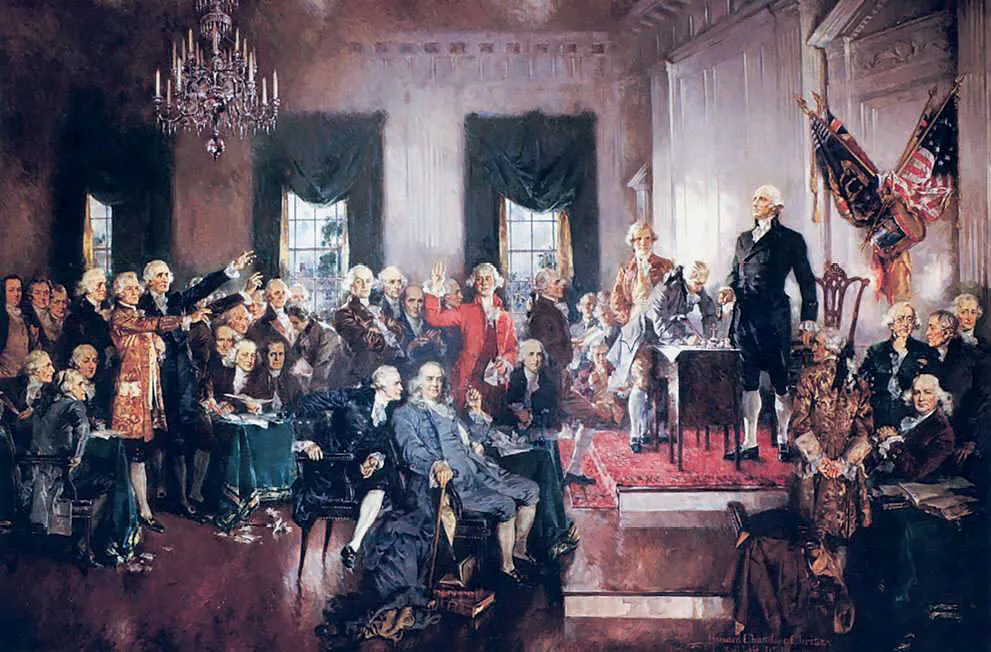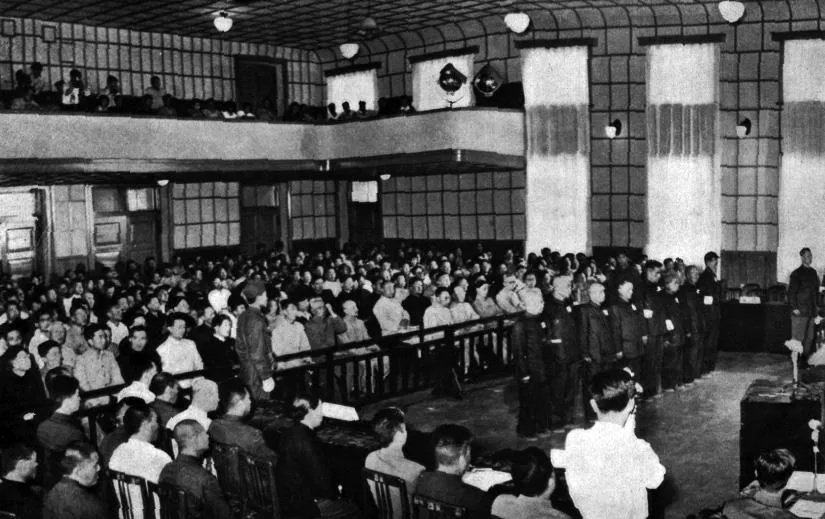Editor’s Note: This article first was published in EIR Vol. 14, No. 37, Sept. 18, 1987, pp. 34–36.
Our federal Constitution of 1787 has endured the tests of time, as no other in the history of mankind has been able to meet that test; it is today, now 200 years old, the oldest living constitution in the world.
For 200 years, there has been little reason to amend it. The first ten amendments, called “The Bill of Rights,” stipulated lessons of law hard learned in the preceding two centuries struggle for civil and religious liberty within both Britain and North America. Those amendments which outlawed the last remnants of slavery and extended the adult franchise to all, have the character of extensions of the Bill of Rights. Otherwise, only changes in the method of selection of, and succession to the President have a constitutional character.
Over the course of time, those amendments have proven necessary; however, their adoption represented no alteration of the original intent.
The other amendments should not have been adopted as part of the Constitution itself; they are merely ordinary legislative law, which special interests saw fit to enact in the form of a constitutional amendment.
This year [1987], we celebrate the anniversary of this Constitution with the publication of a major work currently in progress at the printer, historian Graham Lowry’s How the Nation Was Won. This book fills in what has been previously a blank page in American history—the internal political history of the colonies in North America during the fifty years following the 1688–89 events in England.

During the last half of the reign of England’s Queen Anne, an international conspiracy was raised against the evil English Liberal faction around the Duke of Marlborough. This conspiracy was centered around a then prospective Prime Minister of England, Gottfried Leibniz, and Jonathan Swift in Ireland and England. For a time, this pro-American conspiracy exerted a great influence on the English monarchy, nearly defeating the Duke of Marlborough and his forces.
The forces arrayed around the leadership of Leibniz and Swift, in Europe, reached out to the Americas, to join forces with the American republicans then centered around the leadership of Boston’s Cotton Mather. William Penn, the proprietor of the Pennsylvania colony, helped from, as Penn himself put it, “not above the table,” but effectively. Two royal governors, Robert Hunter (New York) and Alexander Spotswood (Virginia), chosen by Swift’s faction, linked with Cotton Mather’s faction, produced the policies and organization later represented by the chosen protégé of both Mather and Spotswood, Benjamin Franklin.
When Franklin became directly active in Europe for the cause of the future United States, beginning in 1766, it was the same forces earlier grouped around Leibniz and Swift who gave the American cause the support leading to victory in 1783.
Heretofore, serious students of our national history have recognized the roots of our republic in the Massachusetts Bay Colony prior to 1688. Those students have recognized the spirit of the earlier Massachusetts Bay Colony reawakened in the growing resistance here to the British Liberal Party’s efforts to destroy our economy and local self-government. Yet, what happened, between 1688 and the onset of the French and Indian Wars, to maintain and spread the continuity of the Massachusetts Bay Colony’s republicanism, remained buried in archives, neglected by our modem historians.
Now, that glorious, previously missing page from our history is no longer unknown. Putting this missing page into its proper place, is of great practical importance for us today, on two counts.
First, knowing the historical experience which shaped the opinion of the founding fathers, we have no reason to doubt the intent of the authors of our Declaration of Independence and Constitution. The influential, lying socialists whose doctrines of hatred against the Founding Fathers have dictated most of the history curriculum during the past 70 years or so, such as Charles Beard, Arthur Schlesinger, and Walter Lippmann, are now completely discredited, and the influence of their ideas on constitutional practice shown to be a false and pernicious one.
Second, the timely intervention of such figures as Leibniz, Swift, Hunter, and Spotswood occurred at a point in our national history when we seemed doomed to lose everything for which the Massachusetts Bay Colony had been established. Chiefly as a result of the drift of our national policy during the recent 20 years, our republic is now threatened with a destruction of our economy and our liberties as dangerous, and perhaps more so, than that which the circles of Cotton Mather faced at the beginning of Queen Anne’s reign. Knowing now, the whole sweep of our national history over the period 1706–1789, that history, showing how the triumph of 1789 was brought out of the catastrophe of 1688–1706, is a most valuable inspiration for us today, that we might learn how we might again snatch victory from the jaws of a looming national catastrophe.
The danger is a real one. Mrs. Pamela Churchill Harriman, a center of great power inside and outside the Democratic Party’s national leadership today, is mobilizing her forces, including Massachusetts’ Senator Edward Kennedy, for the publicly avowed purpose of convening a constitutional convention to rip up our Constitution, and to substitute a system of government she insists is modeled upon the British parliamentary system.
That means Mrs. Harriman’s Robert Strauss, and Kennedy’s Democratic National Chairman, Paul Kirk. That means longstanding Soviet agent Armand Hammer, and his indicated successor, the wealthy Dwayne Andreas. It means the influential Lloyd Cutler. It means influential forces associated with the Republican Party, as well.
Were those misguided forces to succeed in this disgusting venture, the result would be a sweeping away of that form of government on which our existence has depended for 200 years, and a sweeping away of the last vestige of the protection of our Bill of Rights to citizens generally.
Such an enterprise we must never tolerate. There could be no greater folly than to permit this venture to be pushed forward under present conditions of crisis. Our economy is now in an accelerating collapse of agriculture, manufacturing, and our basic economic infrastructure. We are at the verge of what leading bankers warn will be the biggest financial crash in history—worse than that which Calvin Coolidge bequeathed to President Herbert Hoover’s administration. This economic decay is destroying our national defenses, at a time that the worst strategic crisis of the twentieth century is building up fast.
Our nation faced a crisis nearly as bad as this one, at the time President George Washington was inaugurated. Our national debt was unpayable, our national credit in ruins, and our domestic production and commerce a shambles. Yet, under the composition of government established by our Constitution, the Washington administration implemented Treasury Secretary Alexander Hamilton’s economic and banking reforms; Washington bequeathed to his successor a sound economy, a sound national credit, growing prosperity, and one of the finest quality of military forces in the world at that time. Admittedly, Jefferson and Madison frittered away our national credit, our economic development, and our national defense; but Presidents Monroe and John Quincy Adams, returning to Hamilton’s policies, restored us.
There is embedded in that constitutional tradition of President George Washington’s administration, the means, under our Constitution, and the precedent of Hamilton’s reforms, to cope with the crises of economy, national credit, and debt facing us today, even to deal successfully with the biggest financial crash in history. Without that constitutional system of government, we would be almost helpless to deal with those crises. Worse, under conditions of such severe, unresolved crisis, Mrs. Harriman’s parliamentary system would be but the opening of the door to some form of dictatorship, probably a fascist system similar to the Mussolini model which the late Winston Churchill—her former father-in-law—admired so much, up until the end of 1938.
One of the advantages of our Constitution is that it is so brief, compared with the great length, and many self-contradictory features of other modern constitutions. Except for the attached amendments, it begins with a Preamble, which states clearly and simply the principles of universal natural law which define the mission and philosophy incumbent upon all of our institutions and officials of government. The seven Articles are confined to establishing a system of representative self-government based on three branches, and nothing which is not essential to the process of forming such branches of government, their mutual authorities, and the relationship of the electorate to this process. That is what makes it the best and most durable Constitution ever adopted.
The points of coincidence and difference between that Constitution and the 1776 Declaration of Independence are to be stressed for proper understanding of the Constitution itself.
That earlier Declaration based the existence of our independent republic on the highest authority of law, universal natural law as known to Western European civilization since the writings of St. Augustine, principles richly reaffirmed by the Golden Renaissance centered in Italy. This is a universal law higher in authority than any constitution, any legislative act, any treaty, and any decision by any court.
Nothing of this part of the Declaration of Independence is overturned by our Constitution. Rather, something crucial is added, reflecting the bitter experiences of the arrangements under the decentralized form of government given by the Articles of Confederation. The key passage is, “to form a more perfect Union.” Without that union, and without the centralized form of constitutional, representative self-government required to perfect that union, our nation would not have survived even to the beginning of the 19th century.
All that the Preamble of our Constitution claims as the benefits to be secured by our form of federal government, are the same as those of the Declaration of Independence, except that experience had proved that these objectives could not be realized without a “more perfect Union.”
If there have been reasons to complain against our government, and there have been many legitimate occasions to curse that government out roundly for its follies, the fault does not lie in the Constitution. The fault lies in the voters. Ours is a representative system of government, which means that if the President or the Congress mismanage our affairs, it is the majority of the voters who are to blame for such bad choices. If more among our voters troubled to discover the philosophy of government behind our Constitution, and understood, the experience of history embodied in it, they would choose more wisely, and then they and the Constitution would both be better served.
Otherwise, perhaps we should hold, instead of a convention to change the Constitution, a national assembly to improve the quality of the voters, so that they would not vote in the future for some of the kinds of mistakes they have elected into office, so often, up to the present.
It is that Constitution, embodying the experience of our preceding struggle for a constitutional form of representative self-government, which built our republic to become, formerly, the greatest, most envied nation on Earth. Upon that Constitution depends the continued ability of this nation of ours to survive.







